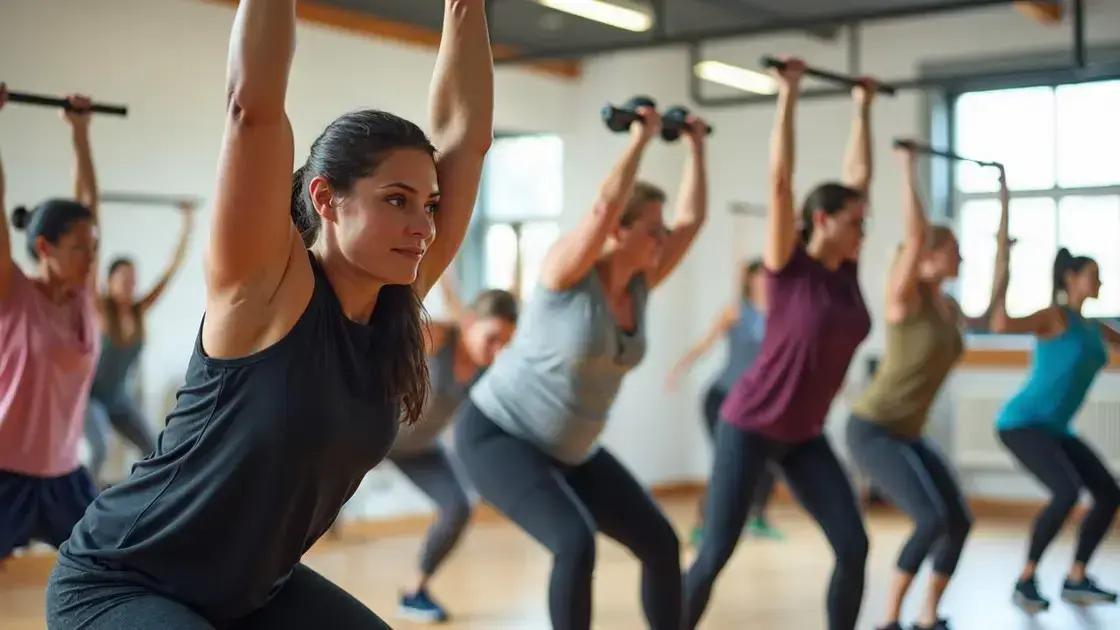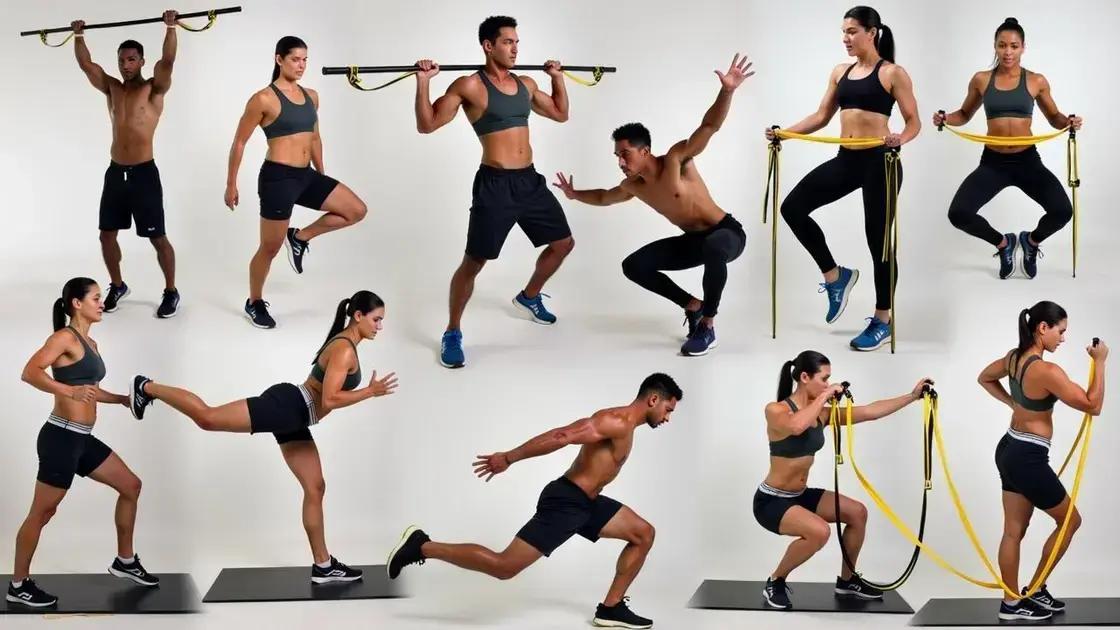Training for power without heavy lifting involves understanding power training concepts, utilizing techniques like bodyweight exercises and plyometrics, and creating a balanced routine that incorporates strength, flexibility, and proper nutrition to enhance overall fitness and reduce injury risks.
Power training is essential for athletes and fitness enthusiasts alike. But did you know that you can train for power without heavy lifting? This method offers a myriad of benefits, including reduced risk of injury and enhanced muscle endurance. In this article, we’ll explore effective techniques, the benefits of non-heavy lifting, and how to create a balanced strength training routine that emphasizes power without the weight. Get ready to unlock your potential!
Understanding Power Training

Power training focuses on enhancing your ability to generate force quickly. It benefits athletes by improving their performance in various sports. Understanding this training type involves knowing how it differs from traditional strength training.
What is Power Training?
Power training emphasizes explosive movements that require speed and strength. Unlike heavy lifting, which often emphasizes maximum weight, power training uses lighter weights but encourages faster, more dynamic movements. Examples include jump squats, kettlebell swings, and medicine ball throws.
Key Principles of Power Training
The effectiveness of power training lies in specific principles:
- Intensity: Aim for 70-90% of your maximum effort for short bursts.
- Speed: Movements should be performed quickly to develop explosiveness.
- Rest: Longer rest periods allow for full recovery, enabling optimal performance in each set.
Who Can Benefit from Power Training?
Both athletes and non-athletes can benefit. Athletes looking to improve sports performance will find it helpful. Non-athletes can gain functional strength for everyday activities, enhancing overall fitness.
Getting Started with Power Training
Before starting, ensure your body is conditioned for such training. Consider incorporating basic resistance training into your program to build strength first. Once comfortable, gradually introduce power exercises into your routine.
Benefits of Non-Heavy Lifting

Non-heavy lifting offers several benefits that make it an excellent strategy for training. Many people fear that lifting lighter weights won’t yield results, but that couldn’t be further from the truth. Here are some compelling reasons to consider this approach.
Reduces Risk of Injury
One of the primary advantages is the lower risk of injury. Heavy lifting can strain joints and muscles if not performed correctly, while lighter weights allow you to focus on form. Good form is crucial in preventing injuries.
Enhances Muscle Endurance
Non-heavy lifting can help improve muscle endurance. By performing more repetitions with lighter weights, your muscles can become more resilient over time. This is especially useful for athletes who need sustained energy and strength over longer periods.
Improves Mobility and Flexibility
Incorporating non-heavy lifting into your routine can also enhance mobility and flexibility. Exercises that focus on lighter weights often involve a broader range of motion, helping you become more flexible. This is beneficial for daily activities and sports.
Accessible for All Fitness Levels
Non-heavy lifting is suitable for everyone, from beginners to advanced athletes. Individuals new to weight training can start with lighter weights to build confidence. More experienced lifters can use this approach for recovery days or to enhance specific muscle groups.
Moreover, this method fosters a more inclusive atmosphere in fitness settings, making everyone feel comfortable in their workouts.
Techniques for Strength Training

Strength training is an essential part of any fitness routine. When focusing on training for power without heavy lifting, various techniques can help you build strength effectively. Here are some methods you can use.
Bodyweight Exercises
Bodyweight exercises are an excellent technique for developing strength. These exercises use your body weight as resistance, making them accessible and effective. Examples include push-ups, pull-ups, and planks. They help improve your strength, balance, and coordination.
Plyometric Training
Plyometric training enhances power through explosive movements. Exercises like box jumps, jump lunges, and burpees focus on quick and powerful actions. This training can increase your strength and speed without heavy weights.
Resistance Bands
Resistance bands are versatile tools for strength training. They allow you to work on various muscle groups by providing adjustable resistance. Incorporate exercises such as banded squats, chest presses, and rows. Bands can also improve flexibility and stability.
Circuit Training
Circuit training combines multiple exercises and can be very effective for building strength. This method keeps your heart rate elevated and boosts endurance while focusing on various muscle groups. A typical circuit might include exercises like lunges, plank rotations, and overhead presses with light weights or resistance bands.
Incorporating these techniques into your routine can help you train for power effectively. They promote strength development without relying on heavy lifting, allowing for a balanced and sustainable approach to fitness.
Creating a Balanced Routine

Creating a balanced routine is vital for anyone training for power without heavy lifting. A well-rounded plan incorporates various training components to improve strength, mobility, and endurance. Here are key elements to consider.
Incorporate Different Training Techniques
Your routine should include a mix of cardio, strength training, and flexibility work. Aim to blend heavy lifting, non-heavy lifting techniques, and functional movements. This balance prevents plateaus and promotes overall fitness.
Schedule Recovery Days
Rest and recovery are essential for muscle growth and injury prevention. Include at least one or two recovery days in your routine each week. This can involve light activities like walking, stretching, or yoga, which help keep your muscles engaged without fatigue.
Set Specific Goals
Define clear and achievable goals for your training. Whether your aim is to improve explosiveness, build endurance, or enhance flexibility, having a target keeps you motivated. Regularly assess your progress and adjust your routine as needed to stay on track.
Monitor Your Nutrition
Nutrition plays a significant role in your training success. A balanced diet rich in protein, healthy fats, and complex carbohydrates fuels your workouts. Hydration is equally important, so drink plenty of water throughout the day to maintain energy levels.
By following these strategies, you can create a balanced routine that supports training for power without the need for heavy lifting. This approach ensures ongoing progress and enjoyment in your fitness journey.
In Conclusion: Training for Power Without Heavy Lifting
Training for power without heavy lifting is not only possible but also beneficial for a wide range of individuals. By focusing on understanding power training, exploring the benefits of non-heavy lifting, and applying various techniques, you can effectively build strength and enhance athletic performance.
Creating a balanced routine that incorporates different training styles, proper nutrition, and recovery is key to achieving your goals. Remember, it’s important to listen to your body and adjust your routine as needed. With dedication and the right approach, you can unlock your full potential while minimizing the risk of injury.
So embrace non-heavy lifting and watch as you gain power, endurance, and greater overall fitness in your journey.
FAQ – Frequently Asked Questions About Training for Power Without Heavy Lifting
What is power training?
Power training focuses on building strength through explosive movements and can be done without heavy lifting.
What are the benefits of non-heavy lifting?
Non-heavy lifting reduces the risk of injury, enhances muscle endurance, improves mobility, and is suitable for all fitness levels.
Which techniques can I use for strength training without heavy lifting?
Techniques include bodyweight exercises, plyometric training, resistance bands, and circuit training.
How can I create a balanced training routine?
Incorporate a mix of cardio, strength training, and flexibility exercises, and ensure you schedule recovery days.
How important is nutrition in my training routine?
Proper nutrition fuels your workouts and aids recovery, so it is essential to maintain a balanced diet rich in nutrients.
Can beginners benefit from non-heavy lifting?
Yes, beginners can start with non-heavy lifting to build strength and confidence before progressing to more intense workouts.













